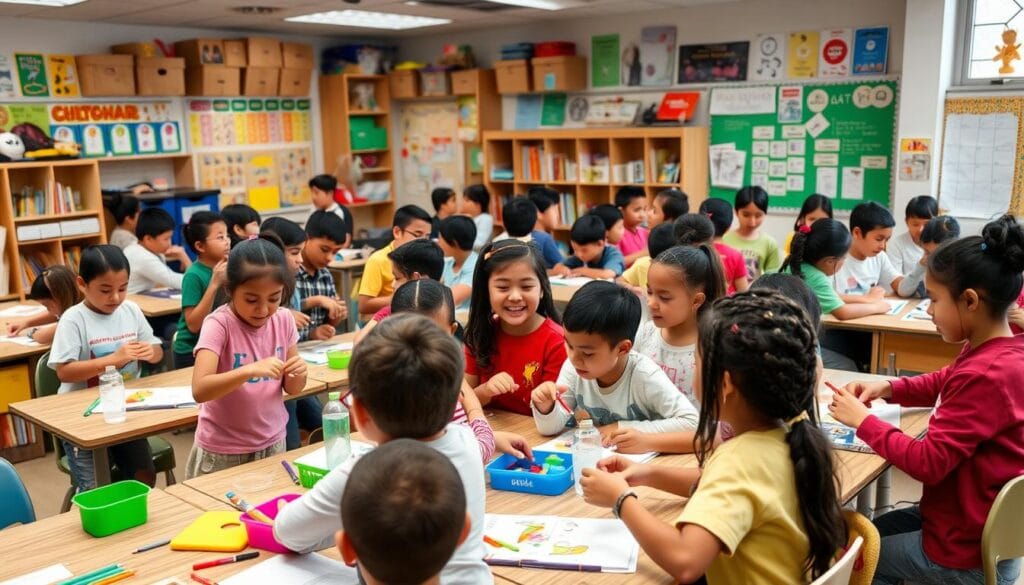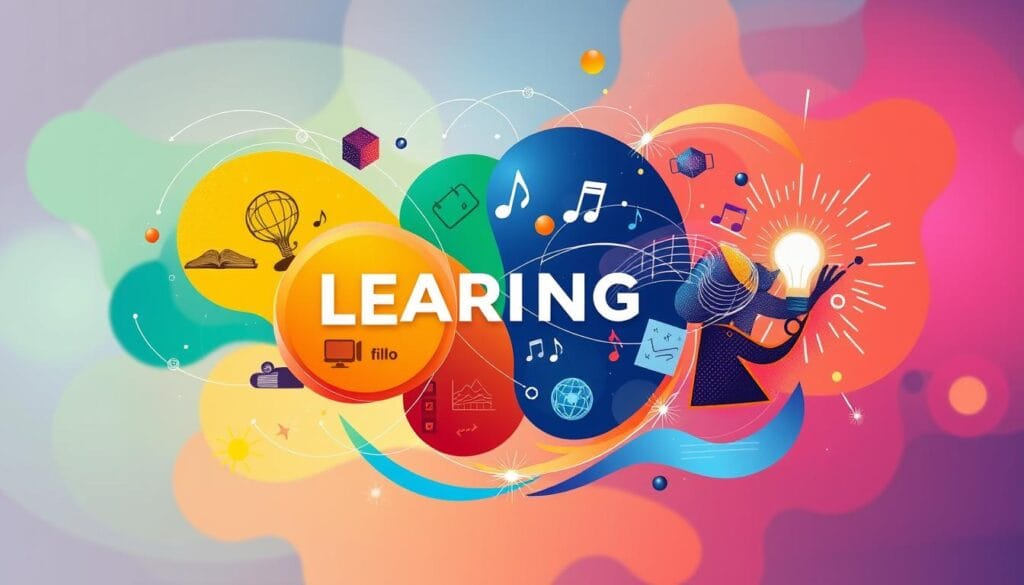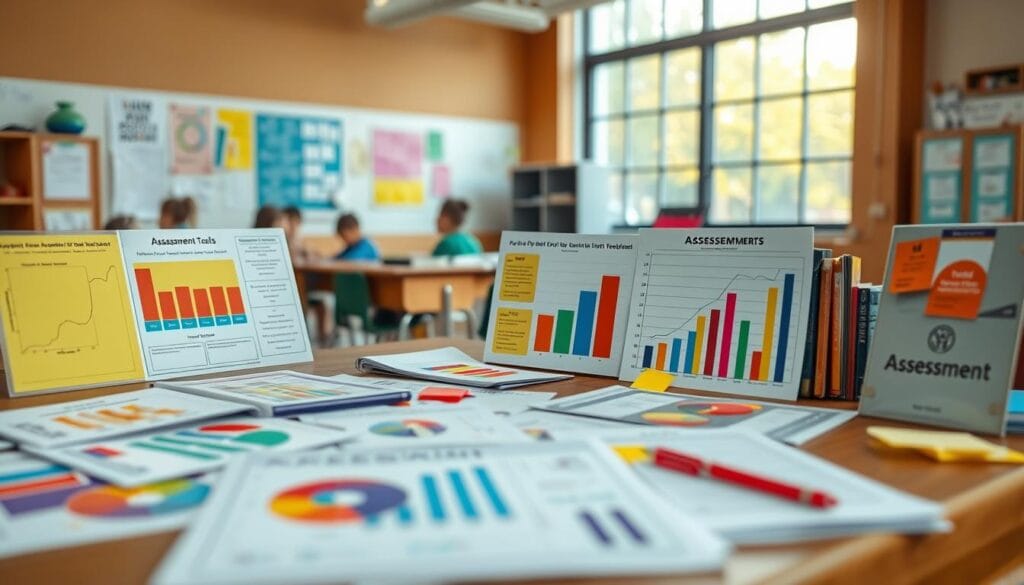The Crucial Role of Teachers in Boosting Student Motivation
As an educator, your role in shaping student motivation is key. Student motivation drives their academic success. You, the teacher, can spark that motivation in your classroom.
By grasping the details of student motivation and using effective teaching methods, you can make learning fun. This creates an environment where students love to learn. It helps them reach their highest potential.
فهرس المقالة
Understanding Teacher’s Role in Student Motivation
Teachers have a big role in making students motivated. Motivation is the drive that makes students want to learn. It’s about being excited and eager to learn new things.
By knowing how to motivate students, we can help them do better in school. We can also make them love learning for the rest of their lives.
Defining Motivation in Educational Context
Motivation in school is about why students want to learn. It’s both about their own interests and things outside of themselves, like rewards.
Impact of Teacher Influence on Learning Outcomes
What teachers do affects students’ motivation and how well they do in school. By creating a supportive learning environment, we can help students reach their full potential.
Core Components of Student Motivation
- Sense of Autonomy: Allowing students to have a voice and make meaningful choices in their learning
- Feeling of Competence: Providing opportunities for students to experience success and mastery
- Fostering Relatedness: Cultivating strong, supportive relationships with students
- Relevance and Interest: Designing learning experiences that are relevant and engaging to students
Understanding these key parts of motivation helps us create a better learning space. It’s where students naturally want to learn and grow.
“Motivating students is not about reward and punishment, but about creating an environment where students want to learn.” – Unknown
| Motivational Theories in Education | Key Principles | Practical Applications |
|---|---|---|
| Self-Determination Theory | Autonomy, Competence, Relatedness | Providing choice, feedback, and fostering positive relationships |
| Expectancy-Value Theory | Expectancy of Success, Perceived Value | Setting achievable goals, making content meaningful and relevant |
| Goal-Setting Theory | Specific, Challenging, and Attainable Goals | Guiding students to set and pursue their own learning goals |
By using these motivational theories in class, we can make a better learning space. This leads to better results for students.
Creating an Engaging Classroom Environment
Creating a supportive learning environment is key to boosting student motivation. As an educator, you can use many classroom management techniques to make your classroom lively and interactive. By planning student engagement activities, you can make learning fun and exciting for your students. This will help them learn better.
Good classroom management begins with clear rules and expectations. Create rules that encourage respect, responsibility, and teamwork. Stick to these rules to keep your classroom organized and productive.
Make sure to include a variety of student engagement activities that appeal to different learning styles. This could be interactive talks, hands-on projects, multimedia shows, or even games. Offering diverse and engaging learning experiences will spark your students’ curiosity and encourage them to participate more.
| Classroom Management Techniques | Student Engagement Activities |
|---|---|
|
|
By setting up a supportive learning environment and using effective classroom management techniques and student engagement activities, you can create a lively and welcoming classroom. This will inspire your students to learn and grow.
“Engaged students are more likely to be motivated, attentive, and invested in their learning.” – Dr. Jane Doe, Education Researcher
Building Strong Teacher-Student Relationships
Creating a good bond between teachers and students is key for a great learning space. When students connect with their teachers, they study better and feel more motivated. Teachers can help students reach their full potential by building strong relationships.
Developing Trust and Rapport
Trust and rapport are the base of a strong teacher-student bond. Teachers show they are trustworthy by being consistent and fair. Listening well and showing real interest in students’ lives also builds trust.
Active Listening Techniques
- Maintain eye contact to show students you are fully engaged.
- Rephrase or summarize what students say to demonstrate you have heard and understood them.
- Ask thoughtful questions to encourage students to expand on their thoughts and ideas.
- Avoid interrupting and allow students to express themselves without judgment.
Showing Authentic Interest in Student Success
Students do better when they know their teachers care about them. Teachers can support students better by learning about their interests and goals. Celebrating their wins and offering feedback helps build a strong bond.
| Effective Strategies for Building Student-Teacher Rapport | Benefits for Student Motivation and Learning |
|---|---|
|
|
“The most valuable resource that all teachers have is each other. Without collaboration, our growth is limited to our own perspectives.”
– Robert John Meehan
Implementing Effective Teaching Strategies
As an educator, it’s key to use effective teaching strategies to boost student motivation and engagement. By using different teaching methods, you can meet the unique needs of your students. Let’s look at some important strategies that can really help.
Differentiated Instruction for Diverse Learners
Students learn in different ways, making differentiated instruction a strong tool. This method lets you adjust your lessons and tests to fit each student’s needs. By offering various ways to learn, you help all students succeed.
Engaging Student Participation
It’s vital to keep students engaged in class. Use activities like group talks, hands-on projects, and multimedia to get them involved. When students are part of the learning, they stay motivated and interested.
Effective Teaching Strategies in Action
“The most effective teachers are those who can adapt their instructional methods to meet the diverse needs of their students. By embracing differentiation and creating engaging learning experiences, you can unlock the full potential of your students.”
Teaching is not a one-size-fits-all job. By always looking for and using effective teaching strategies, you can make a classroom that inspires students to grow.
Using Positive Reinforcement Methods
As educators, we have a big role in helping students succeed. Positive reinforcement is a key strategy. It encourages students and makes the classroom a supportive place.
Verbal Praise and Recognition
Verbal praise can really motivate students. When you acknowledge their hard work, it boosts their confidence. It also encourages them to keep striving for the best.
Reward Systems and Incentives
Reward systems and incentives can motivate students a lot. Clear goals and rewards help them stay engaged. A small prize or special privilege can make them feel accomplished.
Constructive Feedback Approaches
Constructive feedback is key in positive reinforcement. Focus on what they can improve and what they do well. This helps them see where they can grow and celebrate their strengths.
Using these positive methods in your teaching can create a motivating classroom. Remember, the teacher’s role in student motivation is crucial. These methods can greatly improve learning outcomes.
“Positive reinforcement is the most effective way to shape behavior. It’s how I’ve managed to get my dog to do ‘sit’, ‘stay’, ‘fetch’ and a million other tricks.” – B.F. Skinner
Incorporating Student-Centered Learning Activities
Student-centered learning is a great way to keep students engaged and motivated. It lets them take charge of their learning, which boosts critical thinking and teamwork. It also helps them develop a real interest in what they’re learning.
This approach includes many strategies that meet different learning styles. Teachers can make sure that student engagement activities, effective teaching strategies, and differentiated instruction for diverse learners fit well together in the classroom.
- Project-based learning: Students work on real-world projects, using their knowledge and skills in practical ways.
- Collaborative learning: Small groups have discussions, debates, and solve problems together, promoting teamwork and learning from each other.
- Flipped classroom: Students learn at home and then do hands-on activities in class, making learning more interactive.
- Inquiry-based learning: Students explore and discover new things, asking questions and doing research on their own.
Using these student engagement activities, teachers can make a classroom that’s all about the students. It encourages students to take control of their learning and prepares them for the future.

“The best teachers are those who show you where to look, but don’t tell you what to see.” – Alexandra K. Trenfor
It’s important for teachers to use effective teaching strategies that meet the needs of all students. By making learning fit each student’s way of learning, teachers can help every student reach their full potential. This makes sure that all students feel supported, challenged, and ready to reach their goals.
Addressing Different Learning Styles and Needs

Teachers must understand that students learn in many ways. By meeting these differences, you can make learning better for everyone. This part talks about how to teach differently and meet various learning styles and special needs.
Visual, Auditory, and Kinesthetic Learning
Students learn best in different ways. Some like pictures and videos, others prefer listening, and some need to do things hands-on. Using pictures, lectures, and hands-on activities helps each student learn better.
Differentiated Instruction Techniques
Differentiated instruction means teaching in a way that fits each student’s needs. This can mean giving choices, changing the difficulty level, or adding extra help. It helps all students, no matter their abilities, to learn and succeed.
Accommodating Special Learning Requirements
Some students face special challenges like learning disabilities or language barriers. It’s important to help these students feel included. This can mean using special tools, changing assignments, or getting help from experts.
By understanding and meeting the needs of your students, you can teach in a way that helps everyone. Using different teaching methods and creating a welcoming classroom boosts student success and happiness.
Fostering Goal Setting and Achievement
As a teacher, you do more than just teach. You help students set goals and achieve them. This boosts their motivation and helps them grow. It also builds their confidence and self-belief.
Many students find it hard to set goals. By guiding them, you empower them to take charge of their learning. Encourage them to set goals that are specific, measurable, and achievable. This makes goals feel reachable and meaningful.
- Help students break down big goals into smaller steps.
- Check in regularly and give feedback to help them stay on track.
- Celebrate their successes to show how hard work pays off.
Seeing their efforts lead to success motivates students to keep going. By teaching them to set goals, you help them grow academically and personally. This prepares them for a lifetime of success.
“The highest reward for a person’s toil is not what they get for it, but what they become by it.” – John Ruskin
Your role in motivating students is complex. You create a supportive environment, give valuable feedback, and guide them. Your efforts greatly impact their engagement, resilience, and success in school.
Measuring and Tracking Student Progress
As an educator, it’s key to accurately check and keep an eye on your students’ progress. This helps them grow academically and stay motivated. By using good assessment and feedback methods, you can understand what your students are learning. You can also see where they need help and adjust your teaching to meet their needs.
Assessment Strategies
Use different ways to check how well your students are doing. This includes quizzes, class talks, exams, and projects. By doing this often, you can see how each student is doing. This helps you make smart choices about how to teach them best.
Progress Monitoring Tools
- Use tools like learning management systems or student portfolios to track how students are growing over time.
- Use charts and graphs to show how students are doing. This helps both students and their families understand their progress.
- Get students involved in tracking their own progress. This makes them feel more in charge and motivated to learn.
Data-Driven Decision Making
Look at the assessment and feedback practices you’ve collected. This helps you spot patterns and see where students might need extra help. Use this information to make your teaching better and help students do their best.
By taking a detailed approach to tracking student progress, you can help your students succeed. This boosts their motivation and ensures they keep doing well in school.

Overcoming Common Motivational Challenges
As an educator, you might face many challenges in keeping students motivated. One big issue is when students seem disconnected or don’t care about the material. To solve this, use effective teaching strategies that make learning fun and relevant to their lives.
Another problem is when students doubt themselves and don’t want to participate. Create a supportive learning environment by giving positive feedback and celebrating small wins. This helps build their confidence and resilience.
Also, outside factors like family issues can affect a student’s motivation. Use classroom management techniques to build a sense of community. Regularly talk to students, offer counseling, and work with families for a complete support system.
FAQ
What is the teacher’s role in student motivation?
Teachers play a key role in motivating students. They can impact learning by using effective strategies and creating a supportive environment. This environment should engage and inspire students.
How can teachers define motivation in the educational context?
Motivation in school means the reasons students want to learn and succeed. Teachers can understand this by learning about different theories. This helps them meet the needs of their students.
What are the core components of student motivation?
Student motivation comes from within (intrinsic) and from outside (extrinsic). It also includes believing in oneself (self-efficacy) and knowing why they learn (goal orientation). Teachers can use these to boost student engagement.
How can teachers create an engaging classroom environment?
Teachers can make classrooms engaging by managing well and using interactive activities. They should also create a positive atmosphere. This encourages students to participate and try new things.
What are the key elements in building strong teacher-student relationships?
Building strong relationships is key for motivation. Teachers should trust and listen to their students. They should also show genuine interest in their success. This makes students feel valued and motivated to learn.
What are some effective teaching strategies for enhancing student motivation?
Teachers can motivate students by differentiating instruction and using interactive activities. They should also set clear goals and use assessments to help students improve. This approach meets the needs of all students.
How can teachers use positive reinforcement methods to motivate students?
Positive reinforcement, like praise and rewards, can motivate students. Teachers should celebrate student achievements and give feedback that helps them grow. This creates a positive learning environment.
What are the benefits of incorporating student-centered learning activities?
Activities that focus on students, like group discussions and projects, boost motivation. They encourage students to participate, think critically, and work together. This makes them more invested in their learning.
How can teachers address different learning styles and needs?
Teachers can meet different learning needs by offering various options and adapting their teaching. This includes visual, auditory, and kinesthetic learning. It also means providing support for special needs. This makes learning more inclusive and supportive.
What are the key strategies for fostering goal setting and achievement?
Teachers can help students set goals and track their progress. They should guide them, provide feedback, and celebrate their successes. This helps students take charge of their learning and stay motivated.
How can teachers measure and track student progress effectively?
Teachers can track progress by using assessments and data. This helps them see where students need help and adjust their teaching. Regular monitoring helps identify areas for improvement.
How can teachers overcome common motivational challenges?
Teachers can face challenges like disengagement and lack of confidence. They can use effective management and create a supportive environment. By being proactive, they can overcome these challenges and create a motivated classroom.






